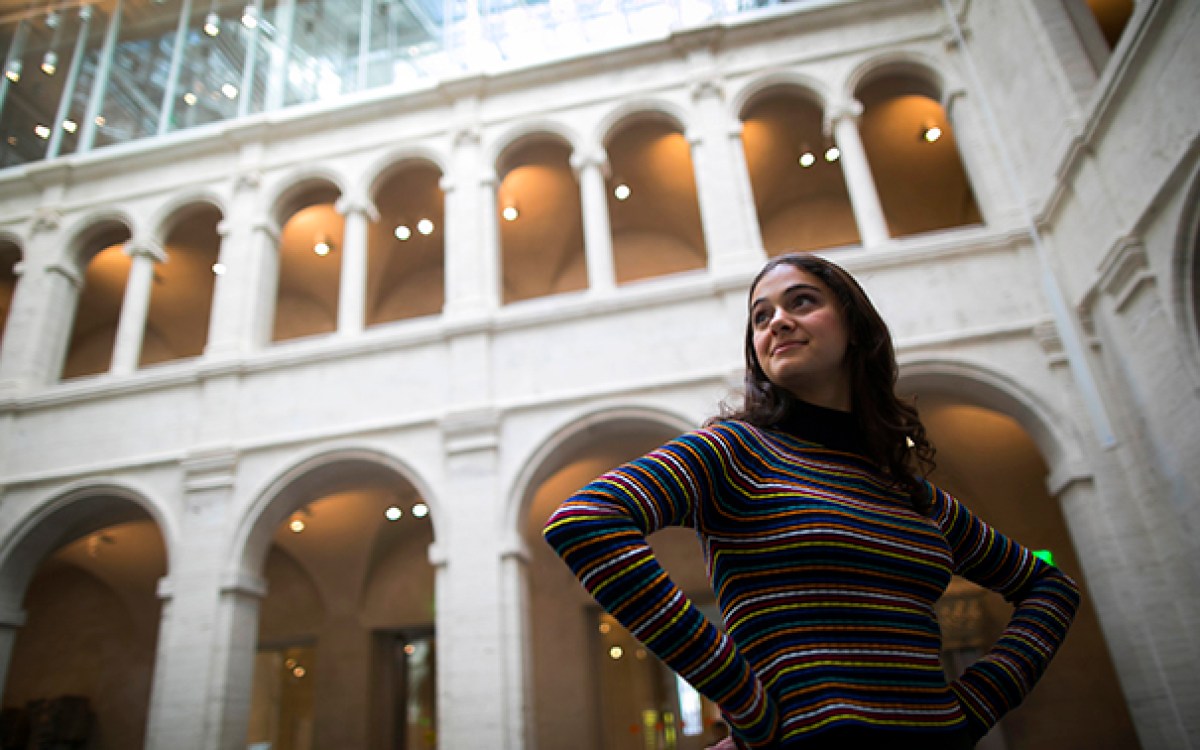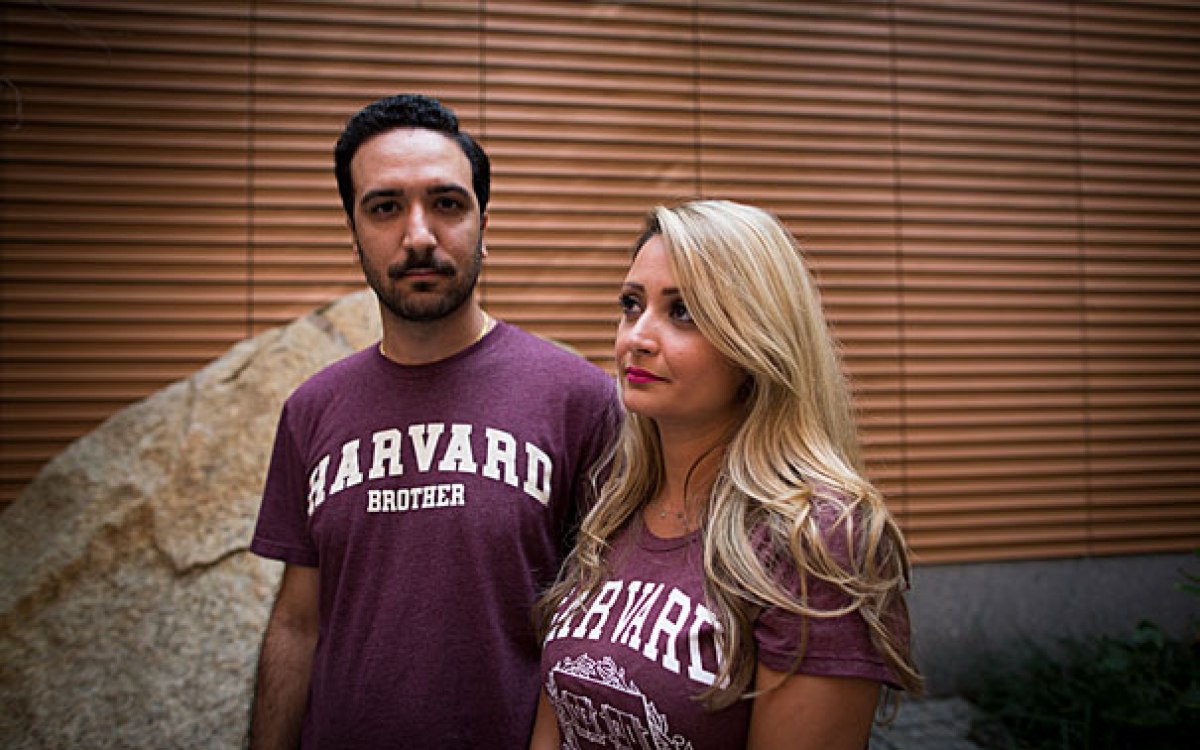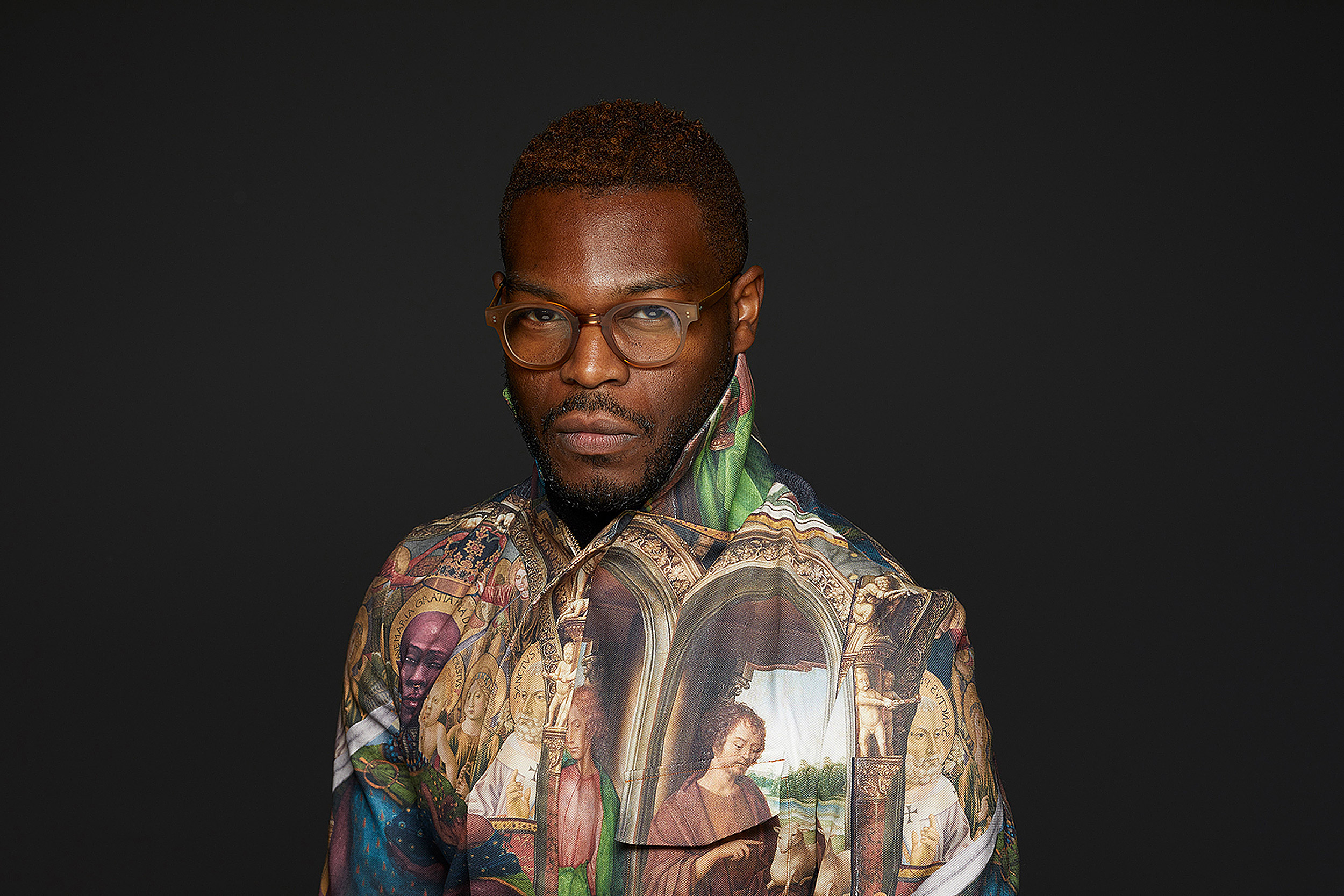
Walé Oyéjidé discusses art and fashion ahead of a screening of his new documentary, “After Migration: Calabria,” on campus Nov. 12.
Photo by Mark Thiessen ©
Confronting bias through fashion
Designer, filmmaker, writer, and record producer Walé Oyéjidé discusses art as a ‘Trojan Horse’ for attitudes and ideas
Walé Oyéjidé has skills. The filmmaker, lawyer, record producer, writer, and fashion designer will be on campus Nov. 12 for a screening of his new project, “After Migration: Calabria” which follows the lives of a group of Africans in southern Italy. The centerpiece of the Harvard University Committee on the Arts event will be a conversation between Oyéjidé, who produced and co-directed the film, and fellow Nigerian American Teju Cole, Gore Vidal Professor of the Practice of Creative Writing, about how storytelling can turn the typical view of migrants as victims on its head. The Gazette recently sat down with Oyéjidé to discuss his fashion label Ikiré Jones, which was featured in the movie “Black Panther,” and how, through his art, he seeks to encourage people to confront their biases.
Q&A
Walé Oyéjidé
GAZETTE: How did you feel about having one of your scarves featured in the movie “Black Panther”?
OYÉJIDÉ: I’m not sure anybody knew going in about the impact that “Black Panther” would have. It has truly become a cultural, global phenomenon. From a business standpoint, it was certainly fantastic for us to have Chadwick Boseman wearing one of our scarves in the film. But for me, what’s really been more interesting has been what it’s meant to me as a person, and to my family. My daughter watched the “Black Panther” DVD, and when she did, she was able to see something that her dad made, in a movie. And that’s normal to her now, and she doesn’t realize that, in fact, that’s pretty extraordinary. I think that ultimately, what we’re aiming for as creatives is for our children to be able to aspire to do much more than what we have accomplished. By seeing things like her father’s design in a major motion picture, my daughter knows that this kind of opportunity isn’t closed to her, as it may have been for so many people of color in the past. The idea that it is normal and standardized to watch, and connect with, a superhero who happens to look like you has been the narrative for a lot of kids from Middle America watching “Superman” for the past 70 years. But it’s been less so a reality for people who look like Chadwick Boseman. “Black Panther” has had a tangible impact on children like my daughter who, now, at an early age, are able to think about whatever their dreams may be, and ask, “Well, why not me?”
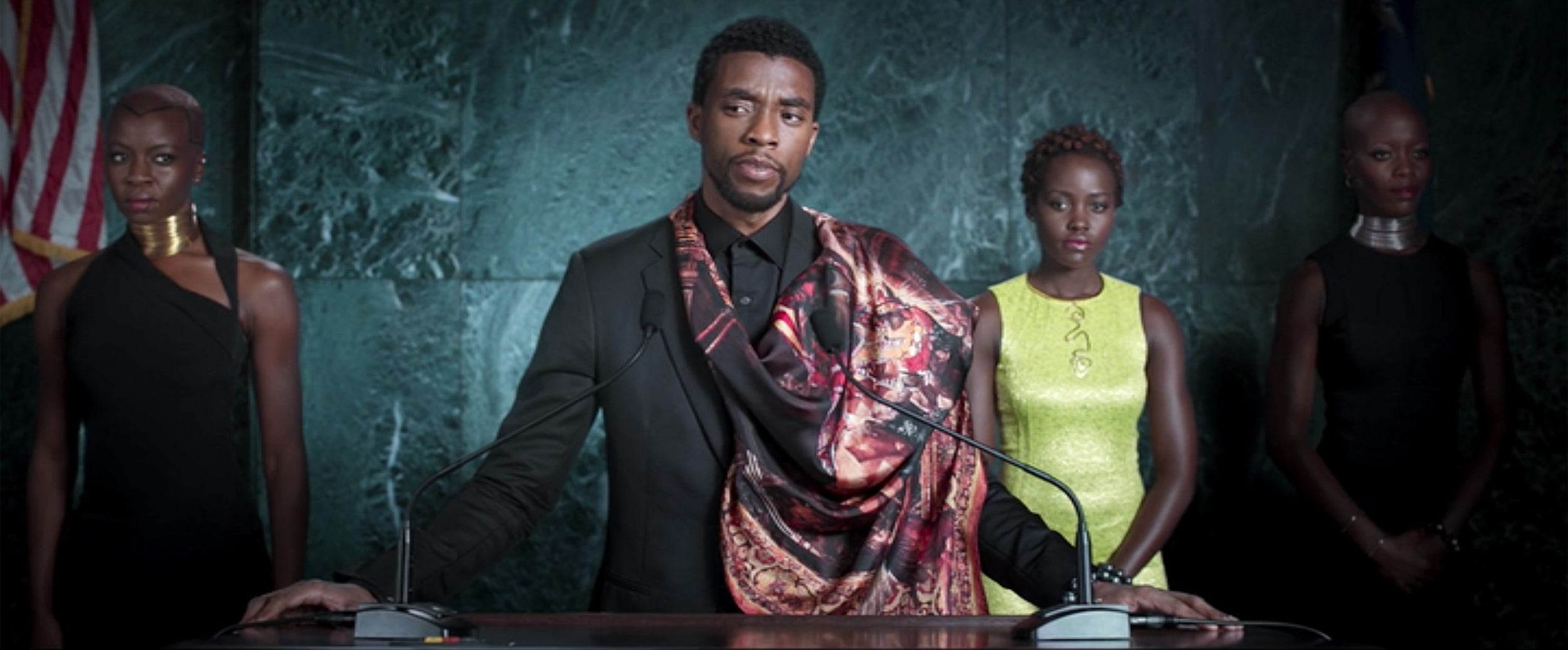
Chadwick Boseman (center) plays the main character in Marvel’s “Black Panther” and wears a scarf designed by Oyéjidé.
Credit: © 2017 – Disney/Marvel Studios
GAZETTE: Several of your suits were on display during the Museum of Fine Arts Gender Bending Fashion exhibition this past summer, here in Boston. Can you talk a bit about how you view fashion and its ability to foil expectation?
OYÉJIDÉ: The MFA exhibition, similarly, provided an opportunity for individuals to think more broadly about who they are and who they can become. I think curator Michelle Finamore asked us to be included because our work is certainly quite bold and colorful, and the expectation has generally been for straight men in the U.S., who of course have historically been the population who have worn suits in our society, to be pretty sober and safe in how they decide to dress. There is a thin margin for what a guy can look like in terms of what they wear, whereas women have a lot more leeway. I think some people have found it refreshing that we’re making traditional suiting that is bold and not a caricature, that is elegant, that you could call aggressive, that you could call beautiful, and is certainly something that catches the eye.

A suit designed by Oyéjidé, featured in a recent fashion exhibit at the Museum of Fine Art.
Photo by Rog Walker ©
GAZETTE: Who do you hope would wear an item from an Ikiré Jones collection?
OYÉJIDÉ: Anyone. You know, I very commonly hear people say, “I don’t know if I could pull it off,” but I personally have been pulling it off for several years now. It’s more about how you walk into a room and the level of confidence you have than it is about what you’re wearing. You could be wearing an Ikiré Jones suit; you could be wearing a burlap sack. If you take yourself seriously, the world will see you as such. This is what I want my work to be about. The idea that we can stretch out, we being men and women, we can wear whatever we want, to stretch out as far as we want to, and go outside of previously established boundaries, and aspire to something different. At the end of the day, it’s not even so much about the clothing, but an individual’s own personal outlook.
GAZETTE: You often talk about this idea of personal outlook, and also, about how individuals are perceived based on their station in life, so to speak. And you aim to alter these perceptions through your work in fashion. How can fashion help to dispel biases?
OYÉJIDÉ: Obviously, fashion is a hugely powerful and influential tool. We all want to wear something that makes us feel confident, whether it’s a power suit, or a bikini, all of us have a thing. We use clothing in many ways to soothe or to bolster our image in society. By the same token, images of people in clothing are used very much to divide. Whether it’s messages of class, whether it’s social separators for what you have or what you don’t have, if you open the pages of Vogue magazine or look on TV, oftentimes these images serve as a force for being exclusive. Because you don’t see yourself in what I call the pantheon of beauty, you assume it’s not for you, that you do not fit into the frame of what is depicted as the highest standard, the apex of what beauty and success could be. Most of us aren’t tall enough, fit enough, sexy enough, or white enough to fit into what is a very narrow view of how beauty is defined. Ikiré Jones seeks to find out what happens when you take the form of fashion, and change it to highlight individuals who generally would be not placed on pedestals in this format. We’re talking about people in our current society who are very much the lowest of the low, and I say that not as a pejorative but as the way in which they’ve been stationed, and in the way that they are described by society. What happens when you take this form, this industry that has been for decades, and continues to be, a force that essentially disempowers wide swaths of the population, and alter it to be more inclusive and empowering?
“’Black Panther’ has had a tangible impact on children like my daughter who, now, at an early age, are able to think about whatever their dreams may be, and ask, ‘Well, why not me?’”
GAZETTE: Specifically, you’re interested in altering the broad narrative around the world’s migrants.
OYÉJIDÉ: My thesis is: Whatever it is you do in life, you should seek to make some sort of difference. I happen to be a designer. I happen to use the tools at my disposal to try and make change happen. I’m also an American, and an immigrant myself, being originally from Nigeria. And I spent part of my youth living in the Middle East. I have to imagine that all of the travel I did when I was a young kid has a lot to do with why I care so much about global issues, generally. The name of the company reflects this: Ikiré is a small town in Nigeria where my dad grew up. And Jones is my wife’s family name — she’s American. The name of the brand is intended to be a marriage of Western and African culture, and to evoke our goal of bringing different parts of the globe together.
GAZETTE: Do you think being a migrant allows you to look at your world with a different perspective?
OYÉJIDÉ: As an immigrant to this country, I’ve seen the struggles of others seeking to make a life in a new land, and I know that most people are all generally doing the best they can for the people who they love the most. You know, when you hop in a cab here in Boston or New York City, the person driving your cab could have very well been a surgeon in their native country. I know these people. These people are all around us. My mother is a physician. She had to start over and do her residency again in the U.S. when she was in her 50s. Whether you’re walking across the border, or cobbling together all the money you can to get a visa, it’s a very real thing for many people all over the world to seek out new opportunities, often on the other side of the world from their homeland, in the struggle toward a better future. So many of these people are discriminated against, and dehumanized, in their work, and in how people interact with them. It’s not an easy issue, and by no means do I intend to trivialize this. Understandably, people have polarizing views. Perceived loss of jobs and culture are real sentiments. But too often, biases color realities. We seek to help people to alter the negative narratives around refugees, and to help migrants focus a renewed, positive sense of self to carry with them in their own lives.
GAZETTE: And you reflect this aspiration in your actual designs, and in the depiction of models wearing Ikiré Jones.
OYÉJIDÉ: That’s right. Our idea is to go to places where people are discriminated against and we take these issues of discrimination, and address them in a format that the population connects with. If it’s Italy, for example, which happens to be the home of high fashion, we take that same format in order to challenge existing biases. With regards to the clothes themselves, we find ways to depict marginalized people as newly empowered, such as in a scarf based on a Caravaggio painting, but that depicts people of color in positions of power, and as beautiful. What does it mean, if you’re a refugee, if your favorite painting now includes someone who looks like you? That’s the layer of the textiles. I liken it to using the trick of the Trojan Horse, except we use beautiful imagery to spark a conversation about the introduction of culture into an unfamiliar place.
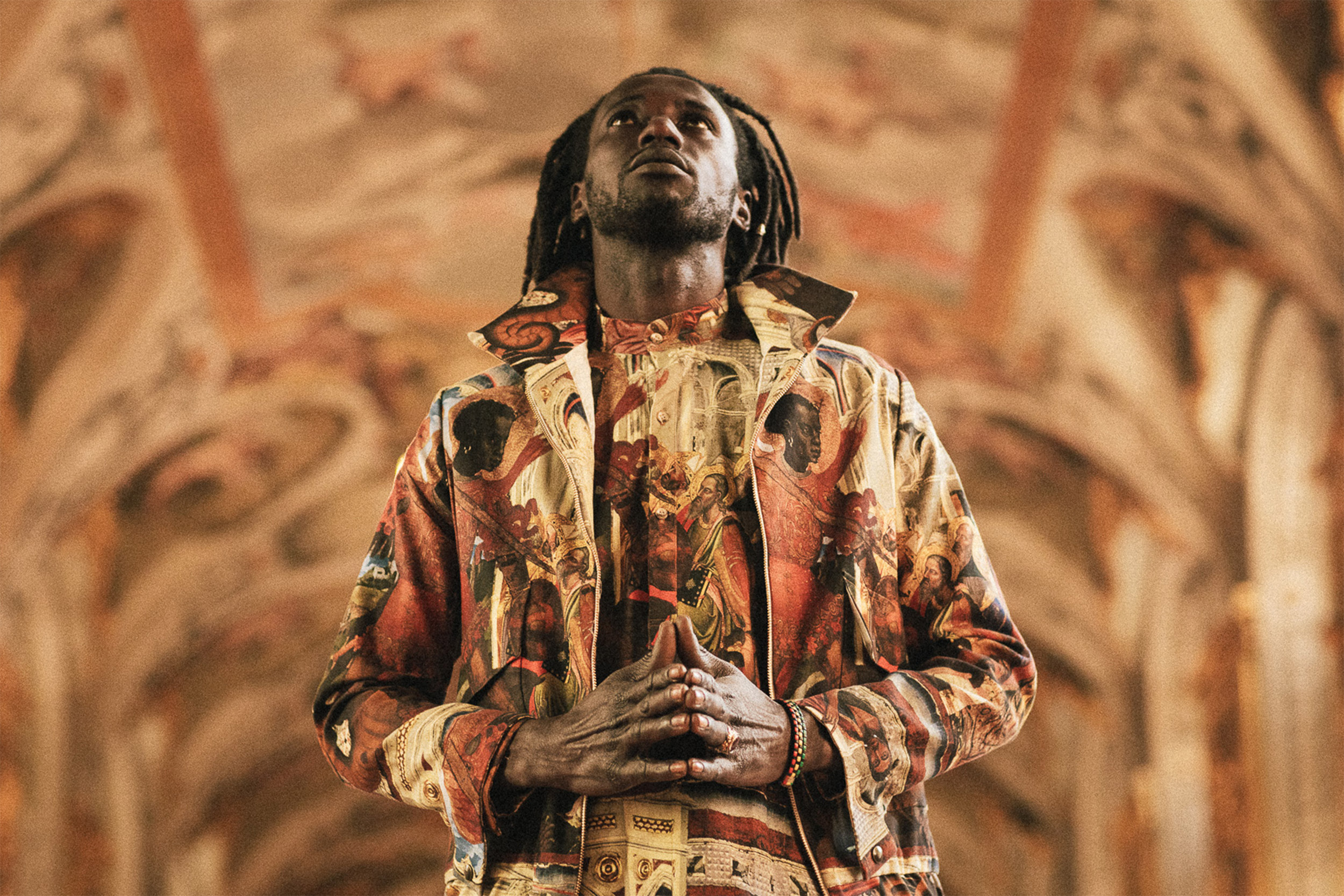
A still from “After Migration: Calabria,” one of Oyéjidé’s personal film projects.
Photo by Neil Watson ©
With regards to the people we hire to showcase our work, instead of outfitting whatever fancy model you can think of, we work with local NGOs on the ground to find gorgeous people who happen to be refugees, who happen to have very troubling stories and histories, and without hiding who they are, we show the most beautiful versions of themselves. This is important for two reasons: One, it is a reminder for these individuals that they are human and worthy of being appreciated and beautiful. And it also gives them a break. In many cases, they’ve spent the past year being dehumanized, and so we then remove them from this recent tragic history and say, “Look in the mirror. This is you; this is what you’re capable of; this is your future; it’s not a stretch. This is what you can be.” This may provide them with a new career, and it also has a broader societal impact. Instead of only seeing a refugee who is here to take my job, perhaps an individual now looks at this person and can simply ask the question: Who are you? What’s your story? You could be my little brother; you could be my cousin; you could be me.
GAZETTE: Next Tuesday, you’ll have the opportunity to discuss your latest project, a short documentary film called “After Migration: Calabria” with a unique storyteller in his own right, the author, critic, photographer, and activist Teju Cole. Talk about your expectations for this event.
OYÉJIDÉ: I’ve been an admirer of Teju’s work for years and am grateful for the opportunity to have a conversation with him. I think what’s particularly unique is the Venn diagram between his work and his perspective, and mine. He’s an accomplished author who, like me, is very well traveled. He’s also, of course, a renowned photographer and photo critic for The New York Times; from that point of view he is looking at work that is very visual. As a fashion designer I use images to create messages of social relevance. I’m looking forward to talking to him and learning from his perspective on the role that images can play in altering conversations that are based in pre-existing biases.
The interview was edited for clarity and condensed for space.
“After Migration: In Defense of Using Beauty to Illustrate the Journeys of Those Who Have Suffered” will take place Nov. 12 from 6:30 p.m. to 8 p.m. in Menschel Hall at the Harvard Art Museums. The event, sponsored by the Harvard University Committee on the Arts, ArtLab, and the Harvard Art Museums, is free, but tickets are required.



